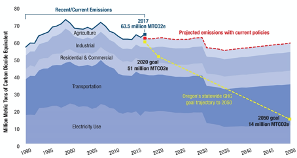Oregon’s Cap and Trade Program (HB2020): An Economic Assessment
Place: Oregon • Date: 2018 • Partner: Oregon Carbon Policy Office
Project Summary
Oregon’s proposed cap-and-trade Policy (HB2020) has established ambitious public commitments to energy efficiency, pollution mitigation, and long-term environmental security. Under the right conditions, these policies have the potential to both limit resource waste and climate risk and promote development of the next generation of clean and energy efficient technologies. However, substantive mitigation policy must recognize some direct and indirect costs. Moreover, the distributional impacts of cap-and-trade policies are largely dependent on the design and conditions related to implementation (Rausch et al 2011).
Figure 1.1: Oregon’s GHG Emissions Targets
The established milestone for GHG reductions in Oregon’s proposed policy, 80% below 1990 levels by 2050, is ambitious and would require Oregon to reduce emissions even faster than it has since 2000 (Figure 1.1). In this report, we examine alternative cap-and-trade policy scenarios that could achieve the 2050 goal, assessing their economic impacts and implications for economic growth. Generally, we find that while there are adjustment costs, the overall benefits to the economy outweigh the costs.
Our approach, which integrates the latest available technology information with a long term economic forecasting model, reveals that innovations in the transportation, electric power, and other sectors can facilitate GHG reductions in ways that confer economic savings on households and enterprises across the state. These savings, made possible by rapid innovation and a pervasive restructuring of the light vehicle fleet and electric power system and other sector innovations can offer a pathway to Oregon’s emission goals that promotes higher economic growth and employment than continuing the status quo. While we cannot predict the details of individual behavior and enterprise decision making, our results clearly reveal the potential of technology adoption and diffusion to reconcile the state’s ambitious climate goals with economic growth objectives. More importantly to individual Oregonians, adoption of already available and forthcoming technologies can offset most of the adjustment costs of decarbonizing the state economy. Indeed, economic savings from energy efficiency and renewable energy can be a potent catalyst for inclusive economic growth.
In terms of the pathway to 2050, we also show that more aggressive technology adoption would permit the state to fulfill the ambitious intermediate (2035) emissions targets in HB 2020. While the 2050 goals would be met under all the scenarios we consider, a more aggressive approach to medium term GHG reduction would reduce total state emissions significantly. On the one hand, steeper targets would increase the cost of compliance. At the same time, more aggressive intermediate GHG targets would improve Oregon’s air quality faster and offer more opportunities for innovation, energy savings, and technology leadership. Balancing these tradeoffs will determine the most appropriate path forward.
Most Recent Entries

Low Carbon Biomass Conversion in the Sierra Nevada







